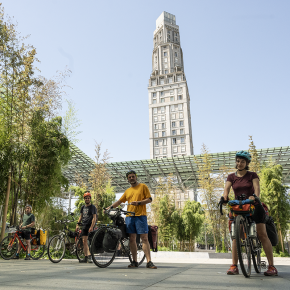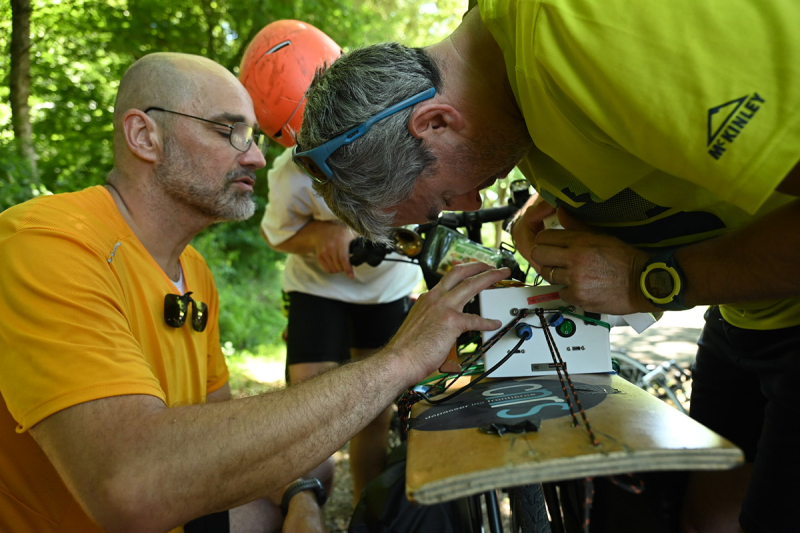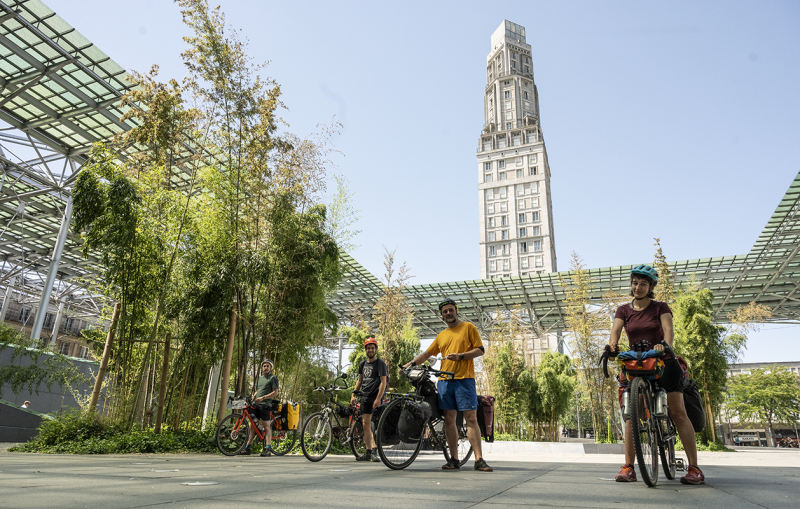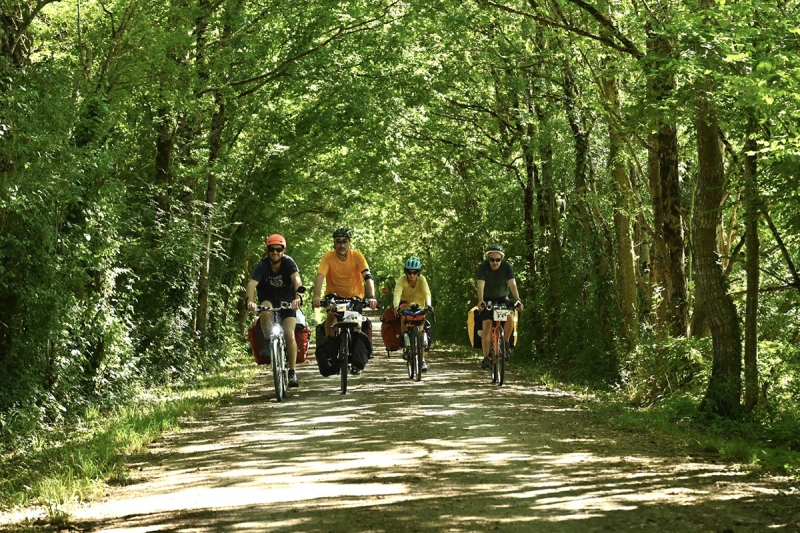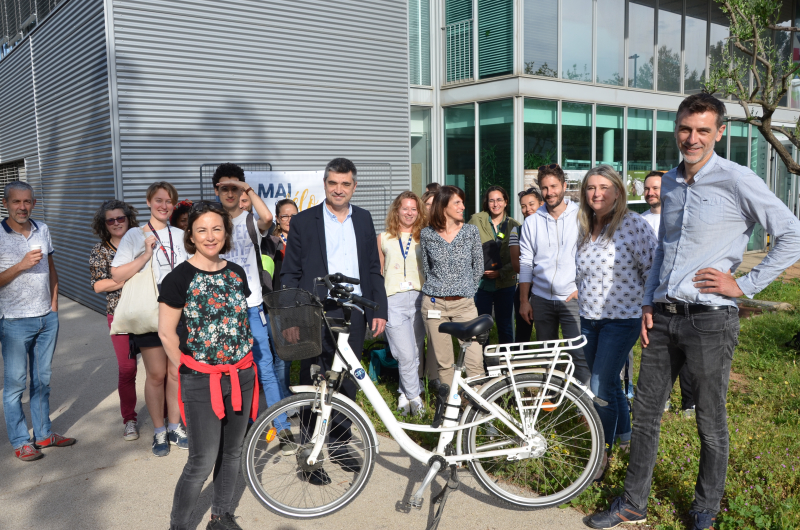'VéloClimat' – science in the saddle
A participatory science bicycle expedition in mid-July from Morbihan to Rotterdam aimed to measure the impact of global warming on cycling and anticipate the most effective changes for adapting to higher temperatures.
800 kms separate Rotterdam and Saint-Jean-la-Poterie in Britanny's Morbihan region. Erwan Bocher, Matthieu Gousseff and their colleagues1 from the Lab-STICC (Research Laboratory in Information, Communication Science and Technology)2 covered that distance in ten days through rain, wind... and the summer heatwave. The challenge for these committed 'cycle commuters' was to reach the Netherlands' second largest city in the most carbon-free way possible to attend the twelfth International Conference on Urban Climate Change (ICUC) in mid-July while measuring and experimenting with the impact of global warming on cycling as they pedalled.
Although cycling is obviously beneficial for the climate and cyclists' health and posited as a solution for adapting to and mitigating global warming by the IPCC, the activity is particularly affected by weather conditions especially during summer heatwaves. However, the poorly adapted cycling infrastructure – for example asphalt tracks under direct sunlight – directly impacts cycling. "When weather conditions are bad, cyclists are likely to abandon their bikes for carbon-emitting modes of transport, mainly cars", sighs Matthieu Gousseff, a CNRS research engineer. His colleague Erwan Bocher, a CNRS research professor, explains that the VéloClimat project aims to anchor science in France's regions. "It's about adapting a carbon-free mode of transport to rapid climate change and anticipating the development of cycle paths straight away".
'Thermo parties' and a heat dome
On June 27th, the Lab-STICC staff members set out from Saint-Jean-la-Poterie where GEOMANUM, the CNRS-sponsored foundation in charge of the VéloClimat project, is based. Their tools for this expedition were 'bike climameters' designed to measure air and ground temperature, microparticle pollution and the closeness of vehicles on both sides of the bikes coupled with physiological sensors to measure their own body temperatures.
"Unfortunately, we were unlucky enough to start out under a heat dome in early July", quips Erwan Bocher ruefully. In the Orne area, the group of cyclists was affected by the heatwave that hit western Europe for two weeks but conversely actually found this an opportunity for research. "Although Alençon's already quite green, we measured a difference at 11 p.m. of six degrees between the surrounding countryside and the city centre, bearing in mind that the urban heat island phenomenon peaks later in the night", explains the research professor. This general observation was backed up by local observations, neighbourhood by neighbourhood. "Depending on the morphology of the buildings and the neighbourhood's vegetation, the temperatures we measured varied a great deal", explains Erwan Bocher. "In some places, the ground temperature on a brand new cycle path went up to 70 degrees! The tarmac was melting and bubbles were bursting on the path..." The heat also had an impact on the researchers' own bodies. Matthieu Gousseff can testify to this as his own body temperature went up to 39.3°C which is considered a fever under normal circumstances.
As well as their own measurements, during their journey the members of the VéloClimat project held 'thermo parties' in the French towns they passed through – Saint-Jean-la-Poterie the day before setting out, Redon in the Ille-et-Vilaine region, Alençon in the Orne region, Lille in the North and finally Ghent, Belgium. These participatory science experiments are in the same vein as the NoiseCapture app developed in 2017 by their laboratory and the Joint Research Unit in Environmental Acoustics (UMRAE)1 . The intention was not just to collect data on a large scale by asking cyclists to ride through their towns' streets with on-board sensors – the researchers also hoped to develop a detailed understanding of local climate zones. The associations asked to take part in these thermo parties were very enthusiastic about the format and the ensuing discussions with participants. "Now we're receiving invitations to host thermo parties in other parts of France", smiles Erwan Bocher. "This supports our idea that a certain segment of the population is waiting for science to give them methodological tools to report on the effects of urban heat islands and then discuss how best to develop the territory with policy makers". This success has led Matthieu Gousseff to work on developing a thermo party format that can be rolled out more broadly or even a kit for associations, because "there's no doubt that thermo parties have attained their dual objective of collecting data and building bridges between research and citizens".
Science is doing the hard yards
If these scientific data are transmitted to local authorities, they could feed into local public policy to help develop regional planning to promote cycling. As proof, the research engineer cites the pleasure of cycling safely and comfortably on Belgian and Dutch cycle paths which result from years of development. The coolness of the greenways and cycle paths shaded by trees in the Benelux countries reduced the heat stress on cyclists, making cycling easier even in hot weather.
- 1Cerema / Université Gustave Eiffel.
Now that the two scientists have returned to Brittany, it is time to take stock and ensure the VéloClimat project's long-term future. Erwan Bocher and his colleagues have already submitted a research project on the same subject to the French National Research Agency (ANR). As well possibly repeating these thermo parties in other places, the scientists now aim to turn this cycling trip to the ICUC conference into a regular event. Beyond its scientific importance, the project had a personal dimension for them that dovetails with scientific knowledge on global warming and the importance of promoting soft mobility. "There comes a time when you've got to go beyond awareness-raising and fundamental knowledge and do the hard yards", insists Matthieu Gousseff. "The margin for scientific progress shouldn't be used as an excuse for not taking action".
The CNRS promotes cycling
The CNRS has been actively promoting cycling and soft mobility since its first carbon assessment. In 2019 motorised vehicles accounted for 34% of the organisation's staff's home-to-work travel and 87% of carbon emissions in this category but now the use of such vehicles has dropped by 10% in three years. Active mobility (walking, scooters and cycling) has gained 20% in usage and such forms of mobility are the primary mode of daily transport (37%) for the CNRS's 33,000 staff members.
This rise in popularity was highlighted by the CNRS's first place in the national employer rankings during the 2024 'Mai à vélo' challenge1 . This was the first time the CNRS took part as a national institution but the involvement of CNRS staff members and joint research units was remarkable. There were almost 1,600 participants and 150,000 km were travelled overall which corresponds to approximately 32 tonnes of CO2 saved in comparison with the equivalent distance travelled by individual combustion engine vehicles. In 2025, the number of CNRS participants rose to 3000 and the number of kilometres travelled were above 200,000 km. This would have represented an equivalent of 43 tonnes of CO2 if the same journey had been made by car.
In the framework of the organisation's ‘Overall Sustainable Development and Social Responsibility Plan’ published in early 2025, the CNRS aims to equip all its sites with dedicated cycle parking spaces by 2027. This policy has been supported since 2023 by the national 'Employeur Pro-Vélo' (Pro-Cycling Employer)2 and 'Alvéole Plus'3 programmes. Around 30 CNRS sites have been registered with the 'Employeur Pro-Vélo' programme, including the majority of our regional offices with five already awarded 'gold'4 and two 'silver' status5 . This means they meet the needs of cyclists in terms of parking, changing facilities or bike repairs and promote cycling through their communications. Alongside these advances, the CNRS also aims to increase the proportion of its employees who cycle to work and benefit from the organisation's sustainable mobility allowance6 from 10% to 20% in three years.
The CNRS hopes cycling will become even more widespread, offering as it does a number of co-benefits for the CNRS and its employees. As well as reducing CO2 emissions and pollutants, cycling offers health benefits and means space can be reallocated for biodiversity and improving quality of life in the workplace. Researchers have estimated that every kilometre travelled by bicycle saves around 1 euro in healthcare costs in France7 .
- 1Since 2020, the national 'Mai à Vélo' (May On A Bike) challenge has been showcasing cyclists looking for alternatives to cars by bringing together teams of employees, schools, residents, neighbours and so on. The overall aim is for people to cycle as many kilometres as possible each day to win the challenge for their team.
- 2The aim of the 'Objectif Employeur Pro-Vélo' programme is to support employers in developing a cycling culture. Incentives enable employers to provide 'Pro-Vélo' equipment and services for the travel of their employees, customers and suppliers.
- 3'Alvéole Plus' is supported by the French Federation of Bicycle Users and aims to provide 100,000 secure parking shelters through funding, advice and training to support their roll-out.
- 4The laboratories IBCP in Lyon and IMPC in Nice, the CNRS campus in Orléans and Grenoble-Polygone and the Lyon regional office website
- 5The CNRS campus Joseph Aiguier in Marseille and Gérard Mégie – the CNRS headquarters in Paris.
- 6The sustainable mobility allowance introduced in May 2020 is a French legislative measure to support and promote the use of low-carbon transport for travel to work. Any CNRS employee who uses one of these modes of transport for at least 30 days a year is eligible.
- 7https://theconversation.com/le-velo-un-potentiel-inexploite-pour-ameliorer-la-sante-et-le-climat-225010
